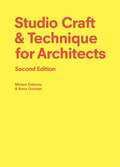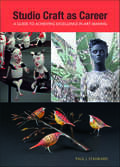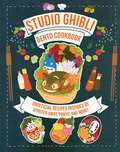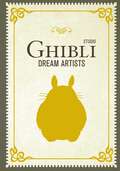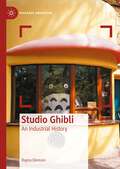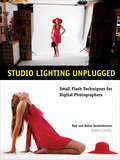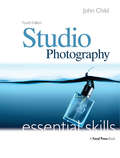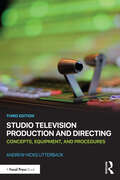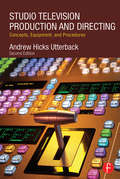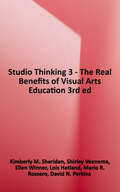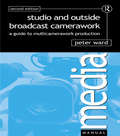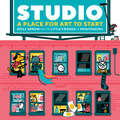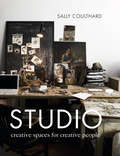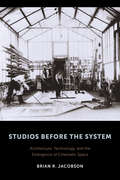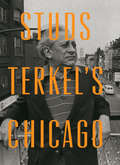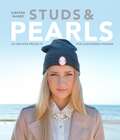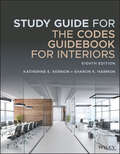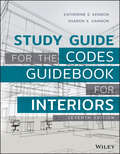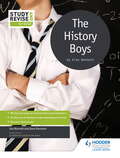- Table View
- List View
Studio Craft & Technique for Architects Second Edition
by Anne Gorman Miriam DelaneyThis one-stop handbook for architecture students provides step-by-step techniques for perfecting the vital skills of drawing, model making and surveying. It is a primer on the conventions of architectural representation and the use of materials. It also explains the primary elements of construction and structure from first principles, using clear diagrams and drawings. Recommended in the first year at numerous architecture schools, this second edition has been updated to include a new section on sustainability, more on types of drawing and when to use them, and more on structural principles and materials.
Studio Craft as Career: A Guide to Achieving Excellence in Art-Making
by Paul J. StankardAmerican master Stankard reveals hard-won career guidance from his 45-year career, plus shares distinguished colleagues' insightsA guided analysis of 150+ top contemporary works helps your own art compete with the bestPersonal advice from the top on ways to pursue creative excellence, with plenty of specific visual examples
Studio Ghibli Bento Cookbook
by Barbara Rossi AzukiCreate ready-to-go, fun, and delicious meals inspired by My Neighbor Totoro, Kiki's Delivery Service, Howl's Moving Castle, Spirited Away, and more with this beautiful bento cookbook celebrating the imaginative worlds of Studio Ghibli!Make delicious bento lunches modeled after your favorite Studio Ghibli movie characters. The easy-to-follow recipes are fun to make and fun to eat! RECIPES FOR FANS: Create Calcifer, No-Face, Ponyo, and more with bentos that celebrate characters from My Neighbor Totoro, Kiki's Delivery Service, Princess Mononoke, Castle in the Sky, Howl's Moving Castle, Spirited Away, and more BEAUTIFULLY ILLUSTRATED, EASY TO FOLLOW: Original illustrations give step-by-step instructions, and inspirational movie scenes remind you of your favorite characters and moments. This cookbook gives you all you need to create ready-to-go lunches that look like the characters and scenery from Studio Ghibli's imaginative movies BENTO BASICS: Learn to cook and assemble your bentos according to state-of-the-art, easy-to-follow techniques. Recipes include gyozas, mochi, chicken tatsuta, miso-sesame green beans, fried zucchini with ponzu sauce, chicken karaage, and many more colorful, tasty, and nutritious recipes
Studio Ghibli Dream Artists
by Insight EditionsCelebrate 40 years of animated filmmaking magic with Studio Ghibli Dream Artists!Since 1985, Studio Ghibli has brought big dreams to the big screen––now, peek behind the curtain to discover the team of artists responsible for Japan&’s most iconic animated films. Both a history and a deluxe art anthology, this book is the definitive compendium on Studio Ghibli&’s visual style, revolutionary storytelling, and fabulous evolution across the last four decades. CLASSIC FILMOGRAPHY: Take an in-depth look at Ghibli classics, from Castle in the Sky (1986) and Princess Mononoke (1997), to Spirited Away (2001) and Ponyo (2008). STUNNING ARTWORK: Take in the gorgeous Ghibli art style like never before with high-quality film stills and posters from the studio&’s all-star line-up of animators and illustrators. A JOURNEY LIKE NO OTHER: Exclusive interviews, recounts, and insights from visionaries including Hayao Miyazaki and Isao Takahata provide vital context about the studio and enrich the experience of watching its most iconic films.
Studio Ghibli: An Industrial History (Palgrave Animation)
by Rayna DenisonStudio Ghibli: An Industrial History takes us deep into the production world of the animation studio co-founded by Oscar-winning director Hayao Miyazaki. It investigates the production culture at Studio Ghibli and considers how the studio has become one of the world’s most famous animation houses. The book breaks with the usual methods for studying Miyazaki and Ghibli’s films, going beyond textual analysis to unpack the myths that have grown up around the studio during its long history. It looks back at over 35 years of filmmaking by Miyazaki and other Ghibli directors, reconsidering the studio’s reputation for egalitarianism and feminism, re-examining its relationship to the art of cel and CG animation, investigating Studio Ghibli’s work outside of feature filmmaking from advertising to videogames and tackling the studio’s difficulties in finding new generations of directors to follow in the footsteps of Miyazaki and Isao Takahata. By reconstructing the history of Studio Ghibli through its own records, promotional documents and staff interviews, Studio Ghibli: An Industrial History offers a new perspective not just on Ghibli, but on the industrial history of Japanese animation.
Studio Jackson: Creative Culture in the Mississippi Capital
by Ellen Rodgers Johnson Nell Linton KnoxIn the capital city of Jackson, visual artists and craftsmen have historically found a place where their work is cherished as part of the local economy. The works span nearly all mediums from sculpting to painting. Beginning in the 1920s with the formation of Wolfe Studios and spanning decades of change and development, Jackson studios have emerged and reigned as the preeminent strongholds of economic development and creative culture in the capital city. Author Nell Linton Knox and photographer Ellen Rodgers Johnson capture the compelling narratives behind some of the well-known craftsmen whose studios are mainstays in Jackson's oldest neighborhoods.
Studio Lighting Unplugged
by Robin Deutschmann Rod DeutschmannThis guide shows photographers how to create studio lighting effects that range from clean and classic to highly complex and use a garage, spare bedroom, or even a backyard as their "studio. "
Studio Lighting Unplugged
by Robin Deutschmann Rod DeutschmannThis guide shows photographers how to create studio lighting effects that range from clean and classic to highly complex and use a garage, spare bedroom, or even a backyard as their "studio. "
Studio Lighting Unplugged
by Robin Deutschmann Rod DeutschmannStudio photography can seem daunting and expensive to the budding photographer, causing many to give up on the idea. However, as Rod and Robin Deutschmann explain in Studio Lighting Unplugged, this needn't be the case when creating professional looking photographs with limited equipment and space. Using small, inexpensive electronic flash units along with budget-friendly stands, communication systems and some do-it-yourself light modifiers, they show readers that it's easy to create refined images in their garages, spare bedrooms and on location.
Studio Photography: Essential Skills (Essential Skills Photography Ser.)
by John ChildStudio photography is a common career path for aspiring photographers and students but the professional and commercial nature of the field makes it a challenging area to break into.Whilst other introductory books on the subject are often bogged down with too much technical detail or too many 'show-off' shots, Studio Photography: Essential Skills offers a practical and accessible guide to the fundamental techniques for successful studio photography. Whether photographing a person or a product, you need control over the light, mood and look to arrive at the perfect result for a particular assignment. This book takes a commercial and creative approach and considers the important elements of lighting, exposure, capture, art direction and the studio setting to ensure a successful shoot.With a clearly structured learning approach and a wide variety of activities and assignments to inspire and engage you, this is an informative, stimulating guide to the basics. Broaden your skills and increase your earning potential with Studio Photography: Essential Skills!
Studio Television Production and Directing: Concepts, Equipment, and Procedures
by Andrew Hicks UtterbackThis updated third edition of Studio Television Production and Directing introduces readers to the basic fundamentals of studio and control room production. Accessible and focused, readers of this updated third edition will learn about essential studio and control room terminology and the common technology package. This book is your back-to-the-basics guide to common technology—including principles of directing, assistant directing, technical directing, playback, audio ops, basic studio lighting, an introduction to set design, camera ops, floor directing, story types (VO, VO/SOT, PKG), basic engineering, and more. Whether an established professional or a student, this book provides readers with the technical expertise to successfully coordinate live or recorded multicamera production. In this new edition, author Andrew Hicks Utterback offers an expanded glossary and new material on visualization walls, alternative camera mounts, basic engineering, and news narrative diagramming.
Studio Television Production and Directing: Concepts, Equipment, and Procedures
by Andrew UtterbackMaster the fundamentals of studio production procedure and become an effective leader on set. Gain fluency in essential studio terms and technology and acquire the skills you need to make it in the industry. Elegant, accessible, and to the point, the second edition of Andrew H. Utterback’s Studio Television Production and Directing is your back-to-the-basics guide to studio-based lighting, set design, camera operations, floor direction, technical direction, audio capture, graphics, prompting, and assistant directing. Whether you are an established studio professional or a student looking to enter the field, this book provides you with the technical expertise you need to successfully coordinate live or taped studio television in the digital age. This new edition has been updated to include: A UK/Euro focused appendix, enhancing the book’s accessibility to students and professionals of television production around the world An advanced discussion of the job of the Director and the Command Cue Language Fresh discussion of tapeless protocols in the control room, Media Object Server newsroom control software (iNews), editing systems, switcher embedded image store, and DPM (DVE) Brand new sections on UHDTV (4K), set design, lighting design, microphones, multiviewers, media asset management, clip-servers, and the use of 2D and 3D animation Expanded coverage of clip types used in ENG and video journalism (VO, VO/SOT, and PKG) An all new companion website (www.focalpress.com/cw/utterback) with pre-recorded lectures by the author, sample video clips, an expanded full color image archive, vocabulary flashcards, and more Note: the companion website is still under development, but in the meantime the author's filmed lectures are all freely available on Youtube: https://www.youtube.com/channel/UCRp_aSpO0y8cDqLjFGZ2s9A
Studio Thinking 3: The Real Benefits of Visual Arts Education, 3rd Edition
by Ellen Winner Kimberly M. Sheridan Shirley Veenema Lois HetlandThe first edition of this bestseller was featured in The New York Times and The Boston Globe for its groundbreaking research on the positive effects of art education on student learning across the curriculum. Studio Thinking 3 is a new edition of a now-classic text, a research-based account of teaching and learning in high school studio arts classes. It poses a framework that identifies eight habits of mind taught in visual arts and four studio structures by which they are taught. This expanded, full-color edition includes new material about how the framework has been used since the original study, with new perspectives from artist-teachers who currently apply the Studio Thinking Framework in their own practice. It also reviews how contemporary organizations, educators, and researchers outside the arts have utilized the framework, highlighting its flexibility to inform teaching and learning. New chapters for Studio Thinking 3: - Students as Contemporary Artists: Building Agency in the Studio highlights how studio teachers support learner autonomy, including the ability to create increasingly self-directed artworks. - Artist-Teachers examines how artistic practices and teaching practices intertwine and how the Studio Thinking Framework can nurture the relationship between them. - Assessment is a Conversation introduces the practical ways that teachers are using Studio Thinking to assess and evaluate students’ work, working processes, and thinking in the arts. - Studio Thinking discusses how the Studio Thinking Framework has informed teaching and research in visual arts, theater, dance, music, arts integration, STEAM, and other contexts. Studio Thinking 3 will help advocates explain arts education to policymakers, support art teachers in developing and refining their teaching and assessment practices, and assist educators in other disciplines to learn from existing practices in arts education.
Studio Time: Future Thinking in Art And Design
by Jan BoelenThe ability to use imagination and envision future needs is crucial in art, design and architecture. Future thinking and making require imagination and capability to create narratives for near and far futures and the capacity to compose proposals to meet the imagined future needs. Future-oriented creative practices also require future literacy―understanding the temporal continuum in which the future-oriented work is created, and being aware of underlying incentives, motivations and structures of the self-initiated works or commissions. Similarly, viewing or consuming the speculative creative works requires some level of understanding of the context of the works. <p><p>Studio Time: Future Thinking in Art and Design approaches these questions with essays from international design and art thinkers, reflective shorter essays and a selection of art, design and architecture projects. The book consists of three parts that each focus on future fictions in art and design from different perspectives: future fictions and imagination in creative practices; future literacy; and future ethics. Each part consists of two essays, two practical, reflective contributions from artists and designers and a selection of art and design projects from practitioners around the world. The book is a closing chapter of Studio Future, which is one of the research studios developed by Belgium-based Z33 House for Contemporary Art. Since 2012, Studio Future has focused on a variety of aspects on future oriented art and design practices through different research and exhibition projects, which have been accompanied by online and offline publishing.
Studio and Location Lighting Secrets for Digital Photographers
by Rick Sammon Vered KoshlanoImprove your photography with more than 200 lighting tips from a top photographerWritten by Canon Explorer of Light Rick Sammon and leading fashion and studio photographer Vered Koshlano, this guide is packed with professional advice on the essential element of photography: lighting. It provides detailed information and insider secrets that are bound to make you a better photographer.You'll learn the basics of studio lighting as well as how to achieve special effects. A 90-minute DVD is included, with additional tips on using reflectors, diffusers, accessory flashes, and more.Explores the basics of studio lighting in various situationsFeatures more than 200 lighting tips and secrets for planning and taking the most impressive digital images in the studioCompares available camera equipment, accessories, software, and printing optionsCovers post-shoot digital darkroom techniques and workflow tips and tricksCompanion DVD includes advice on making the most of accessories such as diffusers, reflectors, and accessory flashesWritten by two top professional photographers and illustrated with full-color examplesStudio and Location Lighting Secrets provides information from the pros to improve your photograpic skills.Note: CD-ROM/DVD and other supplementary materials are not included as part of eBook file.
Studio and Outside Broadcast Camerawork: A Guide To Multi-camerawork Production
by Peter WardStudio and outside broadcast is often done with more than one camera and has its own distinct discipline and operational procedures. Many camera operators now start with single camera operations and have little or no experience of the skills required for multi-camera operation, whereas it used to be the other way round. This book prepared newcomers to multi-camerawork and the techniques required to produce professional results. Studio and Outside Broadcast Camerawork is a revised edition of Multi-Camera Camerawork, including new material on widescreen shooting and an update on BBC (and worldwide) policy of 'shoot and protect' for dual aspect ratio format production.
Studio: A Place for Art to Start
by Emily ArrowBeloved children's entertainer Emily Arrow's first picture book, perfect for (little) makers everywhere: a story about finding a space to create!A young bunny makes the rounds of a studio building, taking in all the different artists in their habitats. Making, thinking, sharing, performing . . . but can our bunny find the perfect space to let imagination shine? In this charming ode to creativity, noted children's singer and entertainer Emily Arrow introduces readers to the concept of the studio: a place for painters, dancers, singers, actors, sculptors, printmakers . . . and you! Whether it's a purpose-made space with big windows, a room filled with equipment, or the corner of a bedroom, your studio can be anywhere--you just have to find it!
Studio: Creative Spaces for Creative People
by Sally CoulthardDiscover what kind of stunning spaces for creative work you can build in your own home no matter your budget with this inspirational DIY guide.Art, craft and all things homemade have never been more popular and the trend for working from home continues apace. But it can be tricky to carve out a space in your house that lets you indulge your passion or earn a living from your creativity. Studio and study spaces are special places—full of creative spirit and practical potential—and there’s never been a greater demand for a book that shows you how to carve out a corner that allows you to not only practice your craft, but inspires and facilitates the very work you create.Real-life case studies from seven different countries, ranging from crafters, writers, designers and artists, show readers just what can be achieved on every budget. Many of the studio owners featured have a dedicated and ever-expanding social media following, including fashion designers Kiel James Patrick and Sarah Vickers, woodworker Ariele Alasko, designer Sarah Sherman Samuel, fine artist Lisa Congdon and decor blogger Holly Becker.Detailed chapters outline the vital pieces needed to create a functioning and inspirational studio space, while also taking an in-depth look into different styles of studios for craft and creative activities. With Studio, Sally Coulthard shows you that spaces for creativity can be easy to make, look beautiful, and fitted into any home.Praise for Studio“A visual feast of a sourcebook . . . features real-life home offices to inspire even the most spatially challenged of us.” —Fabric magazine“A fantastic and inspiring volume.” —Holly Becker“A lovely peek into lots of different creative studios, from potters to knitters, textile designers to fine artist, and every one is a delight.” —The Women’s Room“Working from home has never been so stylish.” —Ham & High
Studios Before the System: Architecture, Technology, and the Emergence of Cinematic Space (Film and Culture Series)
by Brian JacobsonBy 1915, Hollywood had become the epicenter of American filmmaking, with studio "dream factories" structuring its vast production. Filmmakers designed Hollywood studios with a distinct artistic and industrial mission in mind, which in turn influenced the form, content, and business of the films that were made and the impressions of the people who viewed them. The first book to retell the history of film studio architecture, Studios Before the System expands the social and cultural footprint of cinema's virtual worlds and their contribution to wider developments in global technology and urban modernism.Focusing on six significant early film corporations in the United States and France—the Edison Manufacturing Company, American Mutoscope and Biograph, American Vitagraph, Georges Méliès's Star Films, Gaumont, and Pathé Frères—as well as smaller producers and film companies, Studios Before the System describes how filmmakers first envisioned the space they needed and then sourced modern materials to create novel film worlds. Artificially reproducing the natural environment, film studios helped usher in the world's Second Industrial Revolution and what Lewis Mumford would later call the "specific art of the machine." From housing workshops for set, prop, and costume design to dressing rooms and writing departments, studio architecture was always present though rarely visible to the average spectator in the twentieth century, providing the scaffolding under which culture, film aesthetics, and our relation to lived space took shape.
Studs Terkel's Chicago
by Studs TerkelIn a blend of history, memoir, and photography, the Pulitzer Prize winner paints a vivid portrait of this extraordinary American city. Chicago was home to the country&’s first skyscraper (a ten-story building built in 1884), and marks the start of the famed Route 66. It is also the birthplace of the remote control (Zenith) and the car radio (Motorola), and the first major American city to elect a woman (Jane Byrne) and then an African American man (Harold Washington) as mayor. Its literary and journalistic history is just as dazzling, and includes Nelson Algren, Mike Royko, and Sara Paretsky. From Al Capone to the street riots during the Democratic National Convention in 1968, Chicago, in the words of Studs Terkel, &“has—as they used to whisper of the town&’s fast woman—a reputation.&” Chicago was also home to Terkel, the Pulitzer Prize–winning oral historian, who moved to Chicago in 1922 as an eight-year-old and who would make it his home until his death in 2008 at the age of ninety-six. This book is a splendid evocation of Studs Terkel&’s hometown in all its glory—and all its imperfection.
Studs and Pearls: 30 Creative Projects For Customized Fashion
by Kirsten NunezFashion-driven, stylish and hip, Studs & Pearls features 30 customizable projects for you to make – and to make your own. Covering clothing, accessories, jewellery and shoes, each tutorial includes step-by-step instructions and detailed photographs. Inspiration shots show variations of each project, giving over 130 different one-off pieces to try. Designed by Kirsten Nunez, the creator of the highly successful blog www.studs-and-pearls.com, these simple ideas for creating DIY fashion are easy to make and don't require specialist sewing skills.
Studs and Pearls: 30 Creative Projects for Customized Fashion
by Kirsten NunezFashion-driven, stylish and hip, Studs & Pearls features 30 customizable projects for you to make – and to make your own. Covering clothing, accessories, jewellery and shoes, each tutorial includes step-by-step instructions and detailed photographs. Inspiration shots show variations of each project, giving over 130 different one-off pieces to try. Designed by Kirsten Nunez, the creator of the highly successful blog www.studs-and-pearls.com, these simple ideas for creating DIY fashion are easy to make and don't require specialist sewing skills.
Study Guide for The Codes Guidebook for Interiors
by Katherine E. Kennon Sharon K. HarmonSTUDY GUIDE FOR THE CODES GUIDEBOOK FOR INTERIORS The comprehensive study guide for understanding interior codes This revised and updated eighth edition of the Study Guide for the Codes Guidebook for Interiors is an essential companion to The Codes Guidebook for Interiors, the industry’s reference of choice. It offers complete coverage of the major codes and standards that apply to interior projects. This Study Guide includes lists of terms, practice questions, practical application exercises, code tables, and checklists. This companion study guide is a comprehensive measure of a designer’s understanding and application of codes for interior projects. It can help design students learn and practitioners keep their skills up to date and prepare for the NCIDQ and ARE exams. It is vital that designers and architects have an up-to-date working knowledge of the various codes involved with building interiors, whether during renovation or new construction, and this study guide offers the opportunity to: Study with many new questions, in both the short answer and application sections Review the key terms of the industry Use the practice questions and exercises to test working knowledge of codes Utilize the code tables during the design process Employ the numerous checklists on proposed and real life projects to ensure complete compliance The revised Study Guide is a useful companion to The Codes Guidebook for Interiors, the essential reference for all interior professionals. For the designer, architect, or student, the Study Guide for The Codes Guidebook for Interiors is a must-have resource.
Study Guide for The Codes Guidebook for Interiors: Wiley E-text Folder And Interactive Resource Center Access Card
by Katherine E. Kennon Sharon K. HarmonThe comprehensive study guide for understanding interior codes This revised and updated seventh edition of the Study Guide for the Codes Guidebook for Interiors is an essential companion to The Codes Guidebook for Interiors, the industry's reference of choice, with complete coverage of the major codes and standards that apply to interior projects. This Study Guide includes term lists, practice questions, practical application exercises, code tables, checklists, and a book companion site featuring interactive checklists, helping designers and architects check their knowledge and comprehension from reading The Codes Guidebook for Interior chapters and prepare for the NCIDQ and ARE exams. Since The Codes Guidebook for Interiors text covers the latest requirements, standards, terminology, and federal regulations, including the 2015 ICC, the current ADA standards, and ICC/ANSI requirements as well as information on green construction, this companion study guide is a comprehensive measure of designers understanding and application of codes for interior projects. It can help design students learn and practitioners keep their skills up to date. Because it is vital that designers and architects have an up-to-date working knowledge of the various codes involved with building interiors, whether during renovation or new construction, the study guide offers them an opportunity to: Check their knowledge of the key terms of the industry Test their working knowledge of codes using the practice questions and problem scenarios Utilize the code tables during the design process Employ the numerous checklists on proposed and real life projects to ensure complete compliance The revised Study Guide is a useful companion to The Codes Guidebook for Interiors, the essential reference for all interior professionals. Check your understanding of the individual chapters as exam prep or even just as a self-test. For the designer, architect, or student, the Study Guide for The Codes Guidebook for Interiors is a must-have resource.
Study and Revise for GCSE: The History Boys
by Sue Bennett Dave StockwinExam Board: AQA, WJEC, WJEC EduqasLevel: GCSE (9-1)Subject: English literatureFirst teaching: September 2015First exams: Summer 2017Enable students to achieve their best grade in GCSE English Literature with this year-round course companion; designed to instil in-depth textual understanding as students read, analyse and revise The History Boys throughout the course.This Study and Revise guide:- Increases students' knowledge of The History Boys as they progress through the detailed commentary and contextual information written by experienced teachers and examiners- Develops understanding of plot, characterisation, themes and language, equipping students with a rich bank of textual examples to enhance their exam responses- Builds critical and analytical skills through challenging, thought-provoking questions that encourage students to form their own personal responses to the text- Helps students maximise their exam potential using clear explanations of the Assessment Objectives, annotated sample student answers and tips for reaching the next grade- Improves students' extended writing techniques through targeted advice on planning and structuring a successful essay- Provides opportunities for students to review their learning and identify their revision needs with knowledge-based questions at the end of each chapter
